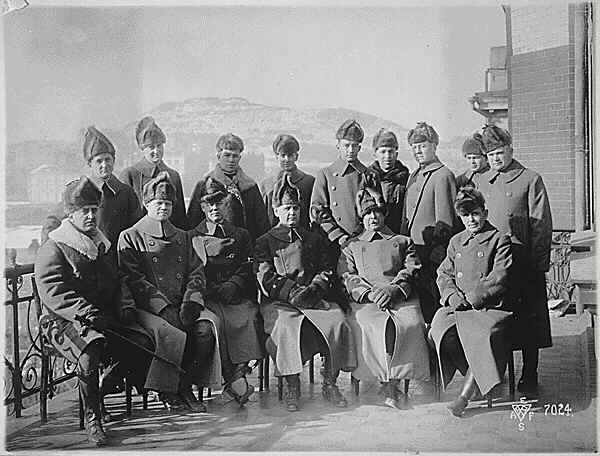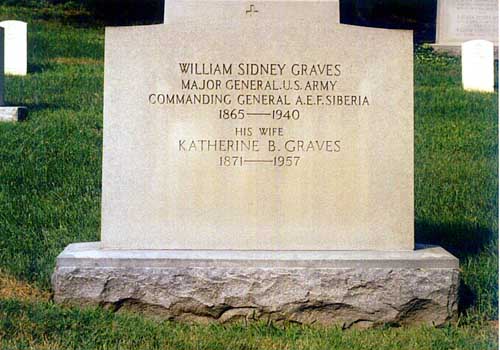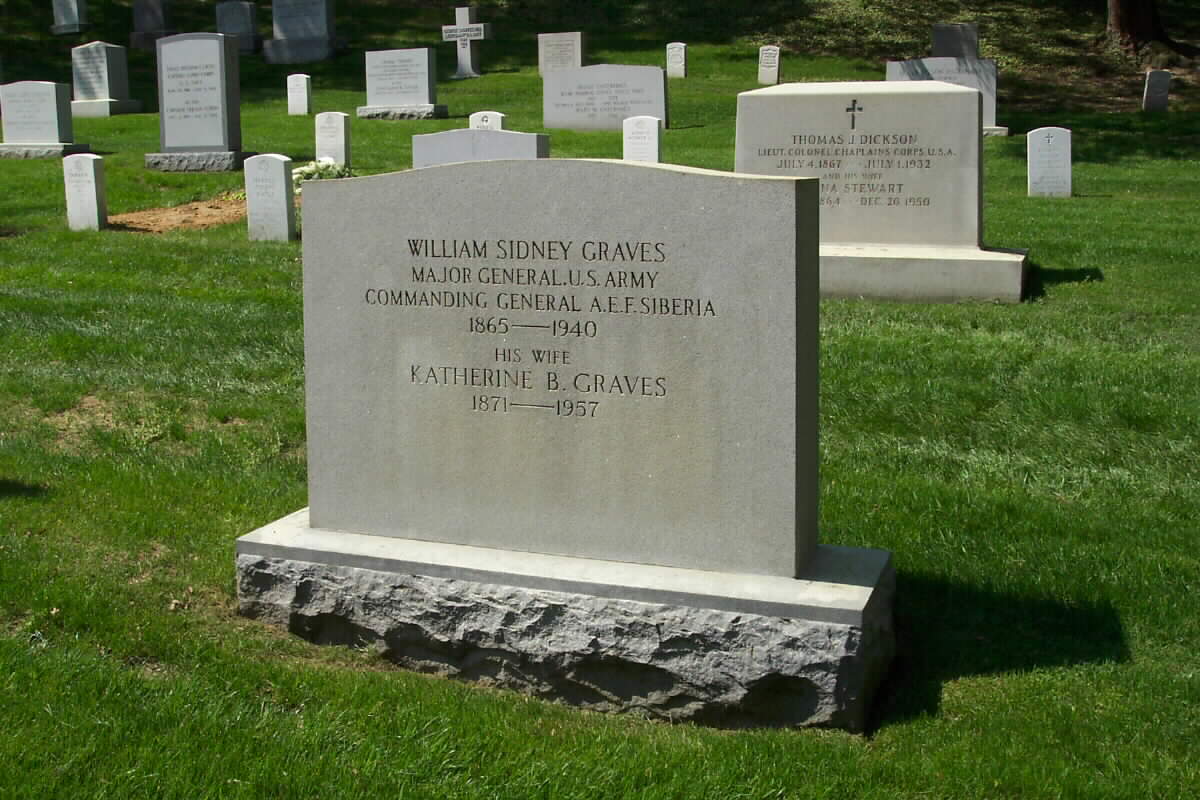Born at Mount Calm, Texas, March 27, 1865, he graduated from West Point in 1889 and was commissioned in the Infantry.
He served with the 7th and 6th Infantry Regiments in the West until 1899, serving in 1898-99 as Acting Judge Advocate General of the Department of the Columbia, receiving promotions to First Lieutenant, November 1896, and Captain, September 1899. He was then ordered to the Philippines for service against the Insurrectionists until 1902.
Garrison duty followed, interrupted by a second tour in the Philippines in 1904-06 and relief work following the San Francisco earthquake in April-May 1906. In 1909 he was assigned to duty with the General Staff in Washington, serving as Secretary in 1911-12 and 1914-18. Promoted to Major in March 1911, Lieutenant Colonel in July 1916, Colonel in June 1917 and temporary Brigadier General in February 1918.
In July 1918, he was promoted to Major General in command of the 8th Infantry Division and in August was relieved of that post in order to undertake a highly secret mission under direct orders of Secretary of War Newton D. Baker. He traveled immediately to Vladivostok, Siberia, taking command of U.S. forces consisting of two Infantry Regiments and auxillary units, 10,000 men in all, whose purpose was to protect Allied military stores in depots along the Trans-Siberian Railway, to render whatever aid possible to the Czech Army stranded in Siberia and to discourage Japanese ambitions to annex Russian territories during the confusion and civil fighting that followed the Russian Revolution. He carried out his orders scrupulously, firmly resisting pressure from British, French and some U.S. diplomats who wished him to take action against Bolshevist factions. The Expeditionary Force was withdrawn from Siberia in April 1920.
He was then briefly commanded of Fort McKinely, Philippines, and then commanded the 1st Infantry Brigade, 1920-25; 1st Infantry Division, 1925; VI Corps Area, Chicago, 1925-26; Panama Canal Division, 1926-28. He retired from the Army in 1928.
He died in Shrewsbury, New Jersey, on February 27, 1940 and was buried in Section 3 of Arlington National Cemetery, near the graves of 7 of the 230 Americans who were killed in the Siberian assignment. He was the recipient of the Distinguished Service Medal for his service in Siberia.
WILLIAM SIDNEY GRAVES was descended from Captain Thomas Graves of Virginia, as follows: Thomas1, John2, Thomas3, John4, John5, Thomas6, Lewis7, Lewis8, Andrew Carroll9, William Sidney10.
Raised as a Central Texas farm boy and known to his family as Billy, Major General William Sidney Graves was destined to leave his mark on world history.
Born in Mount Calm, Texas, on 27 March 1865, he was the sixth son of a Southern Baptist minister, Rev. Andrew Carroll Graves. He attended Military Academy at West Point, New York. He entered class June 15, 1884, and graduated June 12, 1889, ranked 42nd in a class of 49 students academically but 7th in discipline (the seventh fewest number of demerits). This discipline prompted superior officers to recognize his leadership ability, which ultimately led to his promotion to major general.
The newly commissioned Second Lieutenant was immediately posted to frontier duty at Fort Logan, Colorado, where he met his future wife, Katherine Boyd. She was born the daughter of William Boyd and Augusta Merriam on April 5, 1871. They were married February 9, 1891 at Fort Logan, where all four of their children were born.
Initially serving with troops of the 20th Infantry, he soon was selected to serve as aide-de-camp to his commander, Brigadier General H. C. Merriam. During the next several years, Lieutenant Graves served in the usual areas assigned to young officers: commissary officer, ordinance officer, acting judge advocate general, and firing range officer. These duties prevented him from gaining combat experience with his regiment, which had participated in the Spanish-American War, but he was promoted to Captain of Infantry in September 1899 and rejoined his regiment in the Philippine Islands. Serving with distinction in the Philippine Insurrection battling insurgents in Batangas Province as a company commander, he was cited for gallantry by his brigade commander, General J. F. Bell, for action in the battle of Caloocan, 21 December 1901, combat experience that would prove invaluable in his later years of command.
In succeeding years he served as member of the General Staff in Washington, D.C., including stints as Secretary to the General Staff and a tour as the Assistant Chief of Staff of the Army. During this time he came to the notice of President Woodrow Wilson and Secretary of War Newton Baker.
From May 1917 to July 1917 he served on a confidential mission to Great Britain, France, and Belgium, laying the groundwork for the entrance of the United States into World War I. Anxious to become involved in combat again, the now Brigadier General succeeded in obtaining a position as commander of the 8th Infantry Division at Fremont, California (he thought soon to be deployed overseas to the European Theater of World War I) earning him promotion to Major General, National Army.
Soon after arriving in California, he received a wire instructing him to meet with Secretary of War Newton Baker in the Kansas City, Missouri, train station. Baker told Graves that he would “be walking on eggs loaded with dynamite; watch your step”, he had been hand-picked by President Wilson for a very important operation, and that he would lead troops in Russia later to be remembered as The American Expeditionary Forces (AEF) in Siberia.
For some time, the British and French governments had tried to secure American interests in a so-called Eastern Front, hoping to divert German men and materiel away from the main fighting on the Western Front. Their frequent requests were finally approved by American and Japanese governments and Wilson reluctantly agreed to send American troops to Russia to counteract the growing Japanese influence.
Graves’ orders, contained in a secret memo from President Wilson, were to protect Allied military depots along the Trans-Siberian Railway, aid the Czech Legion (a large force of Czechs which had entered the military service of the Russians), and prevent the Japanese from increasing their sphere of influence. He was specifically told not to interfere with Russian internal policy. The memo was deliberately written in such vague terms the details would be left solely to Graves’ discretion. Colonel (later General) Robert Eichelberger, serving with Graves as his assistant chief of staff, stated that Graves was a man with good judgement, coolness, common sense, and the highest integrity; these were the reasons that Wilson picked Graves, and that “he was the best man for the job.”
After arriving in Siberia with 9000 men on September 1, 1918, he quickly became at odds with the British, French, Japanese, Red and White Russian factions, American consulate personnel, Red Cross and other agencies, each of which had their own agenda. Graves’ firmness and diplomacy narrowly averted frequent clashes between American and Japanese forces and he was “not intimidated by the British, French, and Japanese contingents and U.S. diplomatic officials who endeavored to get him to act against Bolshevik factions.” His official obituary in the 71st Annual Report of the Association of Graduates, USMA states, “His
administration of a distasteful duty won him the respect of the Russian people who felt that the restraint imposed on other commanders by General Graves had assisted in checking Allied intentions to dismember their country.” Additionally, “The tide of the Japanese Empire had been diverted southward…” Having completed its task, the AEF left Siberia in 1920.
From October through December in 1925, he served as jury member in the celebrated court martial of General Billy Mitchell. Another notable jury member was General Douglas MacArthur.
General Graves finished his career as commander of the Panama Canal Zone, retired with over forty years service on September 4, 1928, and in 1931 published his book American Siberian Adventure, 1918-1920.
Death claimed Graves from coronary artery disease on 27 February 1940 in Shrewsbury, New Jersey, and he was buried at Arlington National Cemetery with honors commensurate of his rank. Mrs. Graves died Nov. 23, 1957, and is buried at Arlington with her husband. (This information provided by Dr. Thomas L. Graves of Gulfport, Mississippi).
GRAVES, WILLIAM S
MAJOR GEN USARMY RET
- VETERAN SERVICE DATES: Unknown
- DATE OF DEATH: 02/27/1940
- DATE OF INTERMENT: 02/29/1940
- BURIED AT: SECTION SOUTH SITE 4177C
- ARLINGTON NATIONAL CEMETERY
Michael Robert Patterson was born in Arlington and is the son of a former officer of the US Army. So it was no wonder that sooner or later his interests drew him to American history and especially to American military history. Many of his articles can be found on renowned portals like the New York Times, Washingtonpost or Wikipedia.
Reviewed by: Michael Howard



